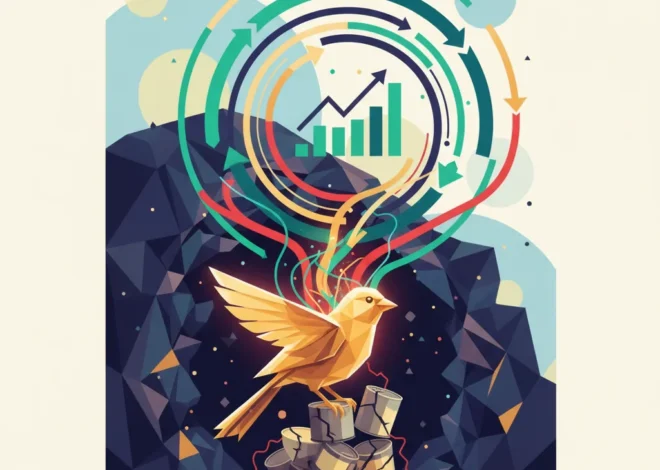
The Shopping Trolley Signal: What One Mother’s Struggle Reveals About Our Economic Blind Spots
The Unseen Data Point: A Story Beyond the Headlines
In the relentless 24-hour cycle of financial news, we are conditioned to react to specific signals: shifts in the Consumer Price Index, quarterly earnings reports, and the subtle nuances of central bank statements. These are the metrics that move markets and shape investment strategies. Yet, sometimes, the most potent economic indicator doesn’t come from a Bloomberg terminal, but from a local news report. A recent story from the BBC detailed the plight of a mother so desperate she was forced to use a shopping trolley to transport her child to a health appointment. On the surface, it’s a heart-wrenching human-interest story—a call for charitable action. But for those in finance, business, and investment, to see it only as such is to miss the flashing red light it represents. This incident is not an anomaly; it is a granular data point reflecting deep, systemic fractures in our economy that have profound implications for long-term stability and growth.
This single, desperate act is a manifestation of immense financial pressure on a segment of the population that is rapidly growing. It speaks to an economy where the cost of basic necessities outpaces wage growth, where the social safety net is fraying, and where financial exclusion locks millions out of the formal banking system. For investors and business leaders, understanding the root causes and cascading effects of such events is no longer a matter of corporate social responsibility, but a crucial component of risk management and strategic foresight. The stability of the stock market is, in the long run, inextricably linked to the stability of the society in which it operates.
From Anecdote to Analysis: Decoding the Economic Stress
The story of the shopping trolley is a stark illustration of the “poverty premium,” a well-documented phenomenon where low-income households pay more for essential goods and services. Lacking a pushchair, a basic tool for child-rearing, is a symptom of a much larger issue. These families often lack access to affordable credit, forcing them into high-interest payday loans. They may not be able to buy in bulk, paying more per unit for food and household items. According to research from the University of Bristol, this premium can cost the average low-income family an extra £490 a year (source)—a staggering sum for those already on the brink.
This financial strain is a direct consequence of macroeconomic trends. While headlines may celebrate a resilient economy or a buoyant stock market, a deeper look reveals a K-shaped recovery. In this scenario, wealthier individuals and large corporations, buoyed by asset price inflation, recover and thrive, while lower-income households see their financial security erode. Persistent inflation in non-discretionary items like food, energy, and housing disproportionately impacts this group, turning what should be manageable expenses into insurmountable hurdles. The need for a charity to appeal for something as fundamental as a pushchair is a clear signal that a significant portion of the consumer base is past the point of cutting back on luxuries; they are now failing to afford necessities.
Beyond the Backlash: Why Smart Money is Still Betting on Corporate Diversity
For the financial world, this erosion of the consumer base is a slow-burning but significant threat. An economy where a growing number of people cannot afford basic goods is an economy with a shrinking addressable market. It signals future weakness in consumer discretionary stocks, challenges for the retail banking sector, and long-term social instability that can disrupt supply chains and depress investor confidence.
The ESG Imperative: Why ‘Social’ is the New Financial Frontier
The rise of Environmental, Social, and Governance (ESG) investing is a direct response to the growing understanding that non-financial factors can have material financial impacts. While the ‘E’ for Environmental has dominated headlines, the ‘S’ for Social is arguably the most critical and least understood component. The social pillar encompasses issues like labor practices, community relations, and consumer welfare—precisely the areas highlighted by the pushchair story.
A company’s long-term value is directly tied to the health and stability of the community it serves. A society with high levels of poverty and inequality is prone to instability, which creates an unpredictable operating environment for businesses. Investing in social infrastructure, either directly or through partnerships, is not philanthropy; it is a strategic investment in a stable future market. A 2021 report by Morgan Stanley found that “companies with strong social-capital performance… demonstrated less stock-price volatility” during market downturns (source), suggesting a tangible financial benefit to strong social performance.
Below is a simplified look at how the rising cost of essential baby items compares to average wage growth, illustrating the financial squeeze on new families.
| Item/Metric | Approx. Cost Increase (Last 5 Years) | Source of Pressure |
|---|---|---|
| Infant Formula | +25% | Supply Chain Issues, Inflation |
| Disposable Diapers | +22% | Raw Material Costs |
| Basic Pushchair/Stroller | +18% | Manufacturing & Shipping Costs |
| Average UK Wage Growth | +15% (Nominal) | Lagging Real-Term Growth |
This data illustrates a fundamental economic divergence. When the cost of entry into parenthood rises faster than wages, it creates a barrier to economic participation and stability for an entire demographic. This is a headwind that will eventually be felt across the entire economy.
Grounded: How a Government Shutdown Clips the Wings of the US Economy and Your Portfolio
The Fintech and Blockchain Solution: From Exclusion to Empowerment
The challenges faced by families in poverty are often compounded by financial exclusion. Lacking a stable address, a regular income, or a credit history can make it impossible to open a bank account, let alone access fair credit. This is where financial technology, or fintech, can play a transformative role. The traditional banking model has failed this demographic, but innovative fintech solutions are uniquely positioned to bridge the gap.
Neobanks and digital-first financial services can offer low-barrier accounts, while AI-driven lending platforms can use alternative data to assess creditworthiness, providing a lifeline beyond predatory lenders. Financial literacy apps can empower individuals to manage tight budgets, and micro-investment platforms can allow for wealth creation with minimal capital. This isn’t just about social good; it’s about unlocking a vast, underserved market. According to the World Bank, 1.4 billion adults are still unbanked globally (source), representing a monumental opportunity for the fintech sector.
Looking further ahead, blockchain technology offers even more radical solutions. Consider the charity in the original story. A blockchain-based supply chain could allow a donor to track their specific donation—be it money or a physical pushchair—from the point of giving to the moment it reaches the recipient family, ensuring unprecedented transparency and efficiency. Decentralized Autonomous Organizations (DAOs) could be formed to create community-governed social support funds, disintermediating traditional structures and putting resources directly into the hands of those who need them. While still nascent, this application of financial technology represents a fundamental rethinking of how we address social and economic inequality.
Gulliver's Curse: The Perils of Immortality in Modern Finance and Investing
Conclusion: A New Calculus for Value
It is easy to dismiss the story of a mother needing a pushchair as a distant, isolated problem to be handled by charities. But this is a profound failure of economic imagination. That shopping trolley is a symbol of a system under stress. It represents a failure not just of social support, but of an economic model that prioritizes abstract market indicators over the tangible well-being of its people.
For the modern investor, business leader, and finance professional, the calculus of value must expand. It must include an assessment of social resilience, financial inclusion, and the real-world purchasing power of the average citizen. The long-term health of our portfolios, our companies, and our economy depends on it. The most astute players in the market will be those who learn to read these unconventional signals—not as tragic anecdotes, but as critical intelligence for navigating the complex economic landscape of tomorrow. The question is no longer whether we can afford to help; it’s whether we can afford not to.


